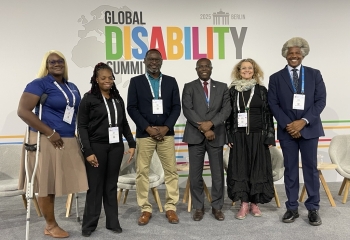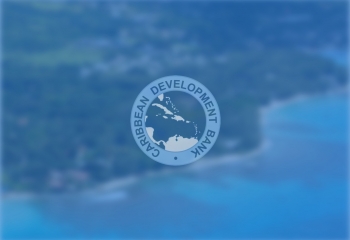Ladies and gentlemen, good morning.
It is my privilege to present an overview of the Region’s economic performance in 2024 and the outlook for 2025. In this presentation, we will examine key economic trends from the past year and highlight areas of notable progress. Additionally, we will assess potential risks and opportunities that may impact our region as we move further into 2025. Finally, we will identify the areas that require our continued attention as we navigate an evolving global and regional landscape.
Economic Review 2024
The region has largely emerged from some of the most severe economic shocks in recent history—COVID-19, supply chain disruptions exacerbated by geopolitical tensions, and the high inflation that followed. These global headwinds tested our resilience, but our Borrowing Member Countries have weathered the storm, and continued to advance steadily.
In 2024, regional output, excluding Guyana, is estimated to have expanded by 1.7%, with fifteen countries now surpassing pre-pandemic real output levels. This performance represents a slowdown from growth of 2.5% recorded in 2023, reflecting the diminishing momentum from the post-pandemic recovery. Growth rates, however varied across Borrowing Member Countries, with Guyana and Haiti standing out as outliers. Guyana was again the standout performer, with its economy surging by 43.5%, fuelled by increased oil production and continued expansion in its non-energy sectors. As a result, when we include Guyana's performance, regional growth rises to 8.8% in 2024, up from 6.6% in 2023, highlighting the country’s significant influence on regional economic growth. On the other hand, Haiti remains in crisis. The country continued to grapple with political instability, escalating gang violence, and high inflation, contributing to its sixth consecutive economic contraction.
For most other countries, growth was moderate. Commodity-exporting economies like Suriname and Trinidad and Tobago continued their modest recovery, from the COVID-19 pandemic. Meanwhile, service-exporting economies, many of which have exceeded their pre-pandemic output levels, grew at a slower pace of 1.6% in 2024, down from 2.8% in 2023 as economies settled into more normal patterns of activity. The tourism industry remained the key driver of growth. Stayover arrivals reached 6.8 million in the first three quarters of the year, with more than half of Borrowing Member Countries surpassing pre-pandemic levels, and some even setting new records. This performance was driven by strong demand from source markets such as the United States, increased airlift, sustained marketing efforts and the hosting of events and festivals across the region. Along with a strong tourism performance, construction activity also provided a major boost to economic growth. Governments across the region prioritised investments in critical infrastructure, including ports, roads, schools, hospitals, and utilities. At the same time, private sector investments helped drive growth in tourism-related construction, with new hotels and commercial properties under development.
While the region made progress, 2024 was also a sobering reminder of our acute vulnerability to natural hazards. Hurricane Beryl, the earliest Category 5 hurricane on record in the Atlantic, had varying impacts on several countries. Grenada’s northern islands of Carriacou and Petite Martinique, as well as St. Vincent and the Grenadines’ southern islands, were hardest hit. Barbados, Jamaica, and the Cayman Islands also felt its impact. This devastating event served as a stark reminder of our region's ongoing exposure to extreme weather events.
On a positive note, inflation continued to moderate in 2024, following global trends. However, price levels remain elevated compared with pre-pandemic times, leading several governments to maintain cost-of-living support measures introduced in prior years. Additionally, unemployment rates continued to decline across most Borrowing Member Countries for which data is available.
Stronger economic activity helped improve fiscal performance across the region. Most governments achieved primary surpluses, mainly reflecting higher tax revenue collections. However, expenditures also increased, driven by recurrent costs, including public sector wage hikes in most countries, and higher capital investments in infrastructure. While debt levels rose by 3.3%, nominal GDP growth contributed to a decline in the region’s debt-to-GDP ratio, which fell to 50.9% from 55.6% in 2023. Nevertheless, debt ratios in nearly half of Borrowing Member Countries remain above 60% of GDP, with ongoing risks to debt sustainability. Governments, however, continued to take steps to achieve or fortify fiscal and debt sustainability, with several of them being able to reduce their debt-to-GDP ratios considerably. These efforts, combined with sustained economic growth, resulted in five countries—Anguilla, Barbados, Belize, Jamaica, and Suriname—receiving upgrades to their sovereign credit ratings in 2024.
In the external sector, higher import payments in some countries dampened the positive impact of increased tourism receipts on their current accounts. However, reserve positions remain healthy, with almost all countries maintaining balances above three months of merchandise imports. The financial sector remained broadly stable, supporting favourable credit conditions.
Outlook for 2025
Looking ahead, regional growth is expected to remain moderate in 2025. Excluding Guyana, the Caribbean Development Bank projects regional growth of 2.5%, with performance varying across Borrowing Member Countries. Guyana’s expansion is expected to slow to 11.9%, following its rapid growth in oil production in 2024. Nevertheless, the country’s performance will remain a key contributor to the region’s economic growth. Hence, including all 19 Borrowing Member Countries, the region is forecasted to grow by 4.6%. Among other commodity exporters, growth is expected to gain momentum as they continue to recover, while service-exporting economies are projected to expand by 2.2%. Tourism is likely to remain a key driver of economic activity. Construction, supported by public and private investments, is also anticipated to contribute positively to near-term economic performance.
On the fiscal front, most governments are expected to maintain primary surpluses, which should further strengthen debt positions in 2025.
While the Caribbean region is on track for continued growth in 2025, there are several risks that could alter this trajectory. Internationally, geopolitical tensions, along with a resurgence of protectionist policies, could elevate uncertainty in global markets, disrupt supply chains, and exert upward pressure on commodity prices. Additionally, policy shifts in the United States, including evolving foreign policy priorities, adds to the uncertainty of the outlook. Potential slowdowns in major trading partners, particularly the United States, could dampen demand for regional exports.
Domestically, the ability to execute critical infrastructure projects on time will be crucial. Delays could hold back growth in industries like construction, energy, and transportation. Moreover, our ever-present vulnerability to natural hazards remains a significant concern. As climate change intensifies, the frequency and severity of extreme weather events increases, and the risk of disruptions to economic activity grows. These natural hazards could not only disrupt economic activity, but in some cases may reverse developmental gains and endanger fiscal and debt sustainability. Adding to these risks, with elections anticipated in many countries in 2025 and 2026, there is an increased likelihood of fiscal pressures and policy shifts that could slow reform momentum.
Development Imperatives
Ladies and gentlemen, for many of our Borrowing Member Countries, sustaining higher growth remains a challenge, burdened by persistent structural challenges. Yet higher growth is necessary to reduce poverty, bridge inequalities, and elevate the standard of living for all citizens and residents of this region. Higher growth is essential—not merely to endure, but to progress. The path forward demands bold action to address these challenges, build resilience, and seize opportunities for inclusive and sustainable growth. To this end, the development imperatives for 2025 and the medium-term are clear.
First, as we just heard from the president, we must build resilience to climate change and natural hazards. Hurricane Beryl’s devastation was a stark reminder of our region’s fragility. We must redouble efforts to climate-proof infrastructure, improve disaster preparedness, and integrate climate considerations into every facet of development planning.
Second, we must address our over dependence on tourism for foreign exchange earnings. Achieving the necessary diversification requires us to build dynamic, internationally competitive economies. In this regard, we need to modernize our road and port infrastructure in a coordinated way that allows us to trade among ourselves, build out potential regional supply chains and connect with international markets. However, it is not enough to build out infrastructure. We also need to modernize and digitalize the regulatory and support systems to reduce the cost of navigating these business processes. Twenty-four-hour operations at ports, electronic port community systems, coordinated sanitary and phytosanitary standards, cold storage facilities and access to appropriate types and levels of finance are just some of the needs in building out a healthy ecosystem for competitiveness and diversification.
Finally, fiscal discipline, risk management and strong institutions remain cornerstones of sustainable growth. Maintaining prudent public fiscal management, while prioritising investments in productive infrastructure and the social well-being of our people is critical. Balancing these needs will require visionary leadership and unwavering commitment.
The road ahead is challenging, but it is also rich with promise. The Caribbean Development Bank stands as a steadfast partner to the region in this journey. We are committed to supporting our Borrowing Member Countries as they pursue these imperatives, providing not only financial resources but also technical expertise and strategic guidance.
As part of this commitment, the Bank will publish a Caribbean Economic Review and Outlook in April 2025. This publication will provide deeper insights into the trends, challenges, and opportunities discussed today. I am confident that this publication will serve as a critical resource to inform our collective efforts, as we chart our path forward towards sustainable development.
Thank you.





